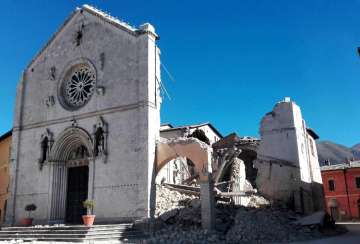Powerful quake rattles Italy; historic 14th century basilica destroyed, no deaths reported
A powerful earthquake with a preliminary magnitude of 6.6 has rocked the parts of central and southern Italy

A powerful earthquake with a preliminary magnitude of 6.6 on Sunday rocked the parts of central and southern Italy, just two months after an intense temblor toppled villages, killing nearly 300 people in the same area.
The latest tremor in the area that witnessed a powerful earthquake in August and a pair of aftershocks last week sent already quake-damaged buildings crumbling including 600-year-old basilica of San Benedetto which had withstood several natural disasters since the end of the 14th century.
Among the structures that have been lost are churches, bell towers and other examples of Italy's cultural heritage.
Sunday's quake is believed to be the strongest to strike the country since 1980. A 6.9-magnitude quake in southern Campania that year killed some 3,000 people and caused extensive damage.
Some 20 people suffered minor injuries. That there were no reports of fatalities was largely due to the fact that thousands had left their homes after the earlier temblors.
Prime Minister Matteo Renzi has vowed that Italy will rebuild the homes, churches and other structures destroyed in the earthquake.
Renzi said the financial resources will be found to restore essential elements of the national identity.
Renzi said at a news conference: "We will rebuild everything — the houses, the churches, the shops. We are dealing (with) marvelous territories, territories of beauty."
He said that despite the strength of the quake "at the moment there is no loss of human life."
Residents already rattled by a constant trembling of the earth rushed into the streets after being roused from bed by the 7:40 a.m. quake. It was felt as far north as Salzburg, Austria, and all the way down the Italian peninsula to the Puglia region, the heel of the boot.
"It is since 1980 that we have had to deal with an earthquake of this magnitude," said Fabrizio Curcio, head of Italy's Civil Protection agency. Curcio was referring to a 6.9-magnitude quake near Naples that killed some 3,000 people and caused extensive damage in November 1980.
Curcio said authorities were responding with helicopters to help the injured and monitor collapses, as many roads were blocked by landslides. Some 3,600 people had already been relocated, many to the coast, following last week's quake, and Curcio said more would follow.
Closest to the epicenter was the ancient city of Norcia, the birthplace of St. Benedict, the father of monasticism, and famed for its Benedictine monastery. Witnesses said the 14th century St. Benedict Cathedral collapsed in the quake, with only the facade still standing.
"It's as if the whole city fell down," Norcia City Assessor Giuseppina Perla told the ANSA news agency. The city's ancient walls suffered damage, as did another famous Norcia church, St. Mary Argentea, known for its 15th century frescoes.
Television images showed nuns rushing out of their church and into the main piazza in Norcia as the clock tower appeared about to crumble. One had to be carried by firefighters, while another was supported as she walked.
The mayor of quake-hit Ussita said a huge cloud of smoke erupted from the crumbled buildings.
"It's a disaster, a disaster!" Mayor Marco Rinaldi told the ANSA news agency. "I was sleeping in the car and I saw hell."
Another hard-hit city, Castelsantangelo sul Nera, also suffered new damage. In Arquata del Tronto, which had been devastated by the Aug. 24 earthquake that killed nearly 300 people, Arquata Mayor Aleandro Petrucci said, "There are no towns left." "Everything came down," he said.
The August 24 quake destroyed the hilltop village of Amatrice and other nearby towns and had a depth of about 10 kilometers (six miles).
Sunday's quake was felt throughout the Italian peninsula, with reports as far north as Bolzano and as far south as Bari. Residents rushed into the streets in Rome, where ancient palazzi shook, swayed and lurched for a prolonged spell.
The quake comes during a long holiday weekend in Italy ahead of Tuesday's All Saint's Day, when Catholics remember the dead. The head of the church in Umbria, Cardinal Gualtiero Bassetti, urged priests not to hold Masses inside churches but in open spaces for fear of further collapses, ANSA reported.
Austria's governmental earthquake monitoring organization said the quake was felt to varying degrees in the east and south of the country and all the way to the city of Salzburg. It says that at its strongest, residents in upper floors noticed a swaying sensation and a slow swinging of hanging objects.
The head of the civil protection authority in Italy's March region, Cesare Spuri, said there have been reports of buildings collapsing in many cities.
"We are trying to understand if people are under the rubble," Spuri said.
In Norcia, nuns knelt in prayer and a firefighter appealed to a priest to help maintain calm among dozens of residents gathered there, including some in wheel chairs.
The church, which had withstood the August earthquake in August and last week's aftershocks, still was standing, but television pictures showed piles of stone had accumulated at the bottom of one wall. One stone was thrown meters into the center of the piazza, illustrating the quake's force.
"We have to keep people calm. Prayer can help. I don't want people to go searching for family members," the firefighter appealed as cameras from SKY TG24 filmed.
The European-Mediterranean Seismological Center put the magnitude at 6.6 or 6.5 with an epicenter 132 kilometers northeast of Rome and 67 kilometers east of Perugia, near the epicenter of last week's temblors. The U.S. Geological Survey put the magnitude at 6.6.
The German Research Centre for Geosciences put the magnitude at 6.5 and said it had a depth of 10 kilometers, a relatively shallow quake near the surface but in the norm for the quake-prone Apennine Mountain region.
(With AP inputs)